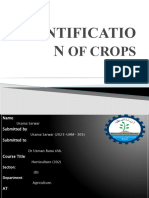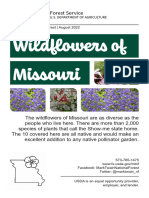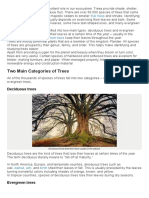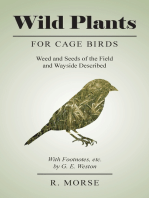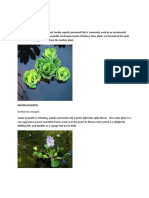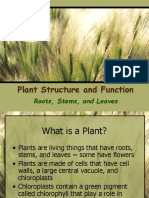Trees of The Battery Visitor Guide
Trees of The Battery Visitor Guide
Uploaded by
ghaCopyright:
Available Formats
Trees of The Battery Visitor Guide
Trees of The Battery Visitor Guide
Uploaded by
ghaOriginal Title
Copyright
Available Formats
Share this document
Did you find this document useful?
Is this content inappropriate?
Copyright:
Available Formats
Trees of The Battery Visitor Guide
Trees of The Battery Visitor Guide
Uploaded by
ghaCopyright:
Available Formats
Trees of The Battery
As you move through the park, use this guide to identify some of the prominent tree species
growing here. Many of the trees can be found in multiple places, but we’ve marked one location for
each on the map below, using the initials of each species’ scientific name. As you locate and read
about each tree, you can check it off in the box provided. Please remember to follow all social
distancing guidelines while at The Battery. We hope you enjoy your visit!
Ca Cedrus atlantica Cf Cornus florida
‘Glauca’ Flowering
Atlas Cedar Dogwood
The Atlas Cedar is an This showy tree flowers in early
evergreen tree native to the spring before the leaves appear.
mountainous regions of In fact, the most striking part of
Morocco and Algeria. The the blooms are the large bracts
cultivar ‘Glauca’ gets its name that surround a cluster of many
from the word glaucous, tiny flowers. The berries ripen
describing the bluish-gray in late summer and are an
color of its foliage. important food source for many
species of birds.
Check out our other visitor guides
and more at www.thebattery.org
Email education@thebattery.org with questions or for list of image sources.
Gb Ginkgo biloba Gd Gymnocladus
Maidenhair Tree dioicus
Kentucky Coffee
Tree
Native to southeast China,
the Ginkgo tree is sometimes Each leaf of this tree is
known as a “living fossil” since compound, made up of 6 to
it has been found in fossils 14 leaflets. The seeds,
dating back as many as 270 contained in large seedpods,
million years. Only the female were once used as a coffee
trees produce fruit and seeds, substitute when roasted, but
which have culinary and the raw seeds are
medicinal uses in some poisonous.
cultures.
Liquidambar Liriodendron
Ls Lt
styraciflua tulipifera
Sweetgum Tuliptree
The Tuliptree is one of the
The wood of the Sweetgum tallest eastern hardwoods,
tree is important for the reaching heights of 80 to 120
timber industry, used for feet. It is a major source of
all manner of furniture. The commercial timber, with wood
name Sweetgum comes used for furniture, musical
from the gummy solid inside instruments, and paper pulp.
the bark, which historically The large flowers provide ample
was used for chewing gum. nectar to many insect
pollinators.
Mg Metasequoia Pa Platanus acerifolia
glyptostroboides London
Dawn Redwood Planetree
The Dawn Redwood is a These trees are known for their
coniferous tree, meaning that it distinctive mottled bark
creates cones rather than pattern, similar to the bark of a
flowers to produce seeds. While Sycamore. In fact, the London
most conifers are evergreen, the Planetree is a hybrid of the
Dawn Redwood is in fact a Sycamore and Platanus
deciduous tree, shedding its orientalis. It was likely first
leaves every fall. developed during the 17th
century.
Pi Prunus x incamp Qb Quercus bicolor
‘Okame’ Swamp White
Okame Cherry Oak
“Bicolor” in this tree’s scientific
Another hybrid species, the name refers to its leaves, which
Okame Cherry was bred to are green above with lighter
provide beautiful foliage, while undersides. Like all oaks, the
maintaining a tolerance for cold Swamp White Oak produces
weather. It is one of the first acorns, which squirrels and jays
cherry trees to bloom in early eat or bury for storage. Thanks
spring. Look for the to those seed predators, the oak
horizontal ridges on the bark, is able to disperse its acorns
called lenticels! farther from the parent tree.
Qpa Quercus palustris Qph Quercus phellos
Pin Oak Willow Oak
The Pin Oak’s name refers Though the leaves of this
not to the bristle tips on the tree appear similar to those
lobes of the leaves, but of willows, its acorns make it
rather to the side twigs, or recognizable as an oak. The
spurs, that form along its Willow Oak begins producing
branches. The indigenous acorns once it is about 15
Lenape people of this area years old, and many types of
used the trunks of these birds and mammals
trees and other oak species depend on the acorns as a
for making canoes. food source.
Sj Styphnolobium Ua Ulmus americana
japonicum American Elm
Japanese
Pagoda Tree
This tree is native to areas of
China and Korea, rather than The American Elm tree was
Japan. The common name historically more abundant
reflects the early cultivation of across the eastern half of the
these trees in Japan near country, but Dutch elm disease,
Buddhist temples. Only large caused by a fungus and spread
trees over 30 years old produce between trees by the elm bark
the aromatic white flowers that beetle, killed more than 75% of
resemble those of the tree’s this tree’s North American
relatives in the legume family: population in the 20th century.
peas and beans.
You might also like
- Mount - Camellia Dewa TairinDocument3 pagesMount - Camellia Dewa Tairinviethoang.20022911No ratings yet
- Lobelia Source: Columbia Electronic Encyclopedia, 6th Edition. Q1 2014, p1-1. 1p. Document Type: Reference Entry AbstractDocument8 pagesLobelia Source: Columbia Electronic Encyclopedia, 6th Edition. Q1 2014, p1-1. 1p. Document Type: Reference Entry AbstractRush YuviencoNo ratings yet
- Common Trees: Dr. H. SantapauDocument10 pagesCommon Trees: Dr. H. SantapauSwarnima TripathiNo ratings yet
- Illustrated Book of Trees HungraphicsDocument190 pagesIllustrated Book of Trees HungraphicsEva Rey Bolle100% (7)
- Good For Nitrogen Fixing and Ecological Restoration Slow GrowingDocument18 pagesGood For Nitrogen Fixing and Ecological Restoration Slow Growingoikos29No ratings yet
- TreesDocument19 pagesTreesSajad AhmadNo ratings yet
- Emag-April-know A TreeDocument6 pagesEmag-April-know A TreeAparna AnandNo ratings yet
- Botanica Eorzea Vol 1Document27 pagesBotanica Eorzea Vol 1Dr Fallout100% (1)
- Urban Gardener 33Document11 pagesUrban Gardener 33Anonymous HXLczq3100% (1)
- Forests I - Tree FactsDocument3 pagesForests I - Tree FactsghaNo ratings yet
- The "Primitive" Flowering PlantsDocument36 pagesThe "Primitive" Flowering PlantsAkif wani100% (1)
- Plants and TreesDocument16 pagesPlants and TreesNicole Steve Callo SacbibitNo ratings yet
- RanunculaceaeDocument61 pagesRanunculaceaedubeyshruti519No ratings yet
- Invasive Flora of the West Coast: British Columbia and the Pacific NorthwestFrom EverandInvasive Flora of the West Coast: British Columbia and the Pacific NorthwestNo ratings yet
- Identification of CropsDocument28 pagesIdentification of Cropsfaisalonlineprintshop9No ratings yet
- Mounting OrchidsDocument8 pagesMounting OrchidsJacksiel Rivas RivasNo ratings yet
- Wild Flowers of IndiaDocument66 pagesWild Flowers of IndiaRoopam Singh100% (3)
- Native Shade PerennialsDocument8 pagesNative Shade PerennialsBecky PhillipsNo ratings yet
- Your Guide To Identifying PalmsDocument10 pagesYour Guide To Identifying PalmsrickomamaNo ratings yet
- Cacti and SucculentsDocument10 pagesCacti and SucculentsjanaNo ratings yet
- LANDSCAPE ARCHITECTUREDocument21 pagesLANDSCAPE ARCHITECTURESujith KsNo ratings yet
- HortiDocument11 pagesHortibhaveshNo ratings yet
- FCBK015 - Know Your ConifersDocument60 pagesFCBK015 - Know Your Conifersvandat1No ratings yet
- Medium TreeDocument7 pagesMedium TreeSahil VirmaniNo ratings yet
- Landscape Design and Site Planning: Assignment-07: VegetationDocument8 pagesLandscape Design and Site Planning: Assignment-07: VegetationSaleha FatimaNo ratings yet
- Maple: From Wikipedia, The Free EncyclopediaDocument23 pagesMaple: From Wikipedia, The Free EncyclopediaHamma AhmedNo ratings yet
- Tropical Rainforest PlantsDocument2 pagesTropical Rainforest PlantsGab PeñaNo ratings yet
- TreeListForTheCityOfOttawa ByDianaBeresford Kroeger 2012Document5 pagesTreeListForTheCityOfOttawa ByDianaBeresford Kroeger 2012EcologyOttawaNo ratings yet
- 10 Different Kinds of TreesDocument5 pages10 Different Kinds of Treesbackup3file2023No ratings yet
- Wild About WildflowersDocument25 pagesWild About WildflowersHeather Ah SanNo ratings yet
- Midterm SolvedDocument8 pagesMidterm SolvedHamna FarooqNo ratings yet
- The Trees of Couchville Lake Arboretum at Long Hunter State ParkDocument12 pagesThe Trees of Couchville Lake Arboretum at Long Hunter State ParkJason K. Allen100% (4)
- No36 AstersDocument11 pagesNo36 AstersDoinitaNo ratings yet
- 18-Observing The ForestDocument2 pages18-Observing The ForestEmergingMovingArchiveNo ratings yet
- Pfeiffer Small-TreesDocument4 pagesPfeiffer Small-TreesFiqoqiNo ratings yet
- Erythrina AbyssinicaDocument5 pagesErythrina AbyssinicaEvolys Digital IncNo ratings yet
- 8 Page Wildflowers MissouriDocument8 pages8 Page Wildflowers MissourilovemahunnyNo ratings yet
- Flora at Sanjay Gandhi ParkDocument9 pagesFlora at Sanjay Gandhi ParkMahesh TejaniNo ratings yet
- Wildflowers Field Guide BW 8.5x11 WebDocument2 pagesWildflowers Field Guide BW 8.5x11 WebMarianaNo ratings yet
- TasNat 1925 Vol1 No4 Pp13-14 Breaden BushRambleDocument2 pagesTasNat 1925 Vol1 No4 Pp13-14 Breaden BushRamblePresident - Tasmanian Field Naturalists ClubNo ratings yet
- Trees Files Miguel FernándezDocument16 pagesTrees Files Miguel Fernándezpilita dinamitaNo ratings yet
- Rainbow ArticleDocument1 pageRainbow ArticleKimball SarmientoNo ratings yet
- Baobab, Adansonia DigitataDocument5 pagesBaobab, Adansonia DigitataDaniel Seth AndalNo ratings yet
- PLANTRESEARCHDocument9 pagesPLANTRESEARCHchristinemangahas5No ratings yet
- Group 4 Plant TableDocument8 pagesGroup 4 Plant TableSomeday -No ratings yet
- Supw ProjectDocument9 pagesSupw ProjectSiddharth Katoch100% (1)
- All Types of Trees Play An Important Role in Our EcosystemDocument89 pagesAll Types of Trees Play An Important Role in Our EcosystemRhea Jean BeresoNo ratings yet
- Investigating The Abiotic Factors That Affect The Size of Ivy Leaves in Shaded and Unshaded HabitatsDocument4 pagesInvestigating The Abiotic Factors That Affect The Size of Ivy Leaves in Shaded and Unshaded HabitatsThesa TagalogNo ratings yet
- VIIS Tree GuideAccessibleDocument2 pagesVIIS Tree GuideAccessibleKerry Josephs-ThomasNo ratings yet
- Portulacaria AfraDocument4 pagesPortulacaria AfrajvnraoNo ratings yet
- The Alphabet Book Wendy Sysouphat 2019 Extra NotesDocument17 pagesThe Alphabet Book Wendy Sysouphat 2019 Extra Notesapi-472615243No ratings yet
- Plant Guide: Blue ElderberryDocument6 pagesPlant Guide: Blue ElderberrySamsonSavageNo ratings yet
- River Birch: Betula NigraDocument8 pagesRiver Birch: Betula NigraSaurabh SinghNo ratings yet
- Deciduous Forest BiomeDocument22 pagesDeciduous Forest BiomeArlanosaurus100% (2)
- Wild Plants for Cage Birds - Weed and Seeds of the Field and Wayside Described - With Footnotes, etc., by G. E. WestonFrom EverandWild Plants for Cage Birds - Weed and Seeds of the Field and Wayside Described - With Footnotes, etc., by G. E. WestonNo ratings yet
- Aquatic Plants: Nelumbo Nucifera, Also Known As Indian Lotus, Sacred Lotus, Bean of India, or Simply Lotus, IsDocument6 pagesAquatic Plants: Nelumbo Nucifera, Also Known As Indian Lotus, Sacred Lotus, Bean of India, or Simply Lotus, IsJoseph Rosales Dela CruzNo ratings yet
- Aquatic PlantsDocument6 pagesAquatic PlantsJoseph Rosales Dela CruzNo ratings yet
- Attracting Birds and Butterflies: How to Plant a Backyard Habitat to Attract Winged LifeFrom EverandAttracting Birds and Butterflies: How to Plant a Backyard Habitat to Attract Winged LifeRating: 3.5 out of 5 stars3.5/5 (2)
- Pistia Stratiotes: Water LettuceDocument20 pagesPistia Stratiotes: Water LettuceRussel Jazzer ArellanoNo ratings yet
- Thorny Busges and ShrubsDocument15 pagesThorny Busges and Shrubssourav BNo ratings yet
- Grow Your Own Victory Garden PDFDocument4 pagesGrow Your Own Victory Garden PDFshedza100% (1)
- Effects of Fruiting Spur Thinning On Fruit Quality and Vegetative Growth of Sweet Cherry (Prunus Avium)Document8 pagesEffects of Fruiting Spur Thinning On Fruit Quality and Vegetative Growth of Sweet Cherry (Prunus Avium)Juan M Garcia CondeNo ratings yet
- Physiological Principles of Dryland Crop ProductionDocument11 pagesPhysiological Principles of Dryland Crop Productiontarandeep kaur100% (3)
- TRANSPORT IN PLANTS Updated ZimsecDocument24 pagesTRANSPORT IN PLANTS Updated ZimsecnatashamautsiNo ratings yet
- Proposal-Revised 3Document26 pagesProposal-Revised 3Usman Baderul HishamNo ratings yet
- Chapter 1 Introduction To Plantation IndustryDocument65 pagesChapter 1 Introduction To Plantation Industryezat syafiqNo ratings yet
- Course Content Agron 105Document3 pagesCourse Content Agron 105Delnaz BehalNo ratings yet
- Pollinator PreferencesDocument4 pagesPollinator Preferencesapi-510366840No ratings yet
- Daffodils: Did You Know? The Earliest Known Reference To Daffodils Can Be Found inDocument5 pagesDaffodils: Did You Know? The Earliest Known Reference To Daffodils Can Be Found inbiba 4lifeNo ratings yet
- BPH - C - 706 - L - Pharmacognosy Lab II - (4 HR/WK) Course ObjectivesDocument2 pagesBPH - C - 706 - L - Pharmacognosy Lab II - (4 HR/WK) Course ObjectivesHarshal PawarNo ratings yet
- I. A. Table 1: Flower Parts Illustration Example: Systematics Act. 3 Phytography: FlowerDocument19 pagesI. A. Table 1: Flower Parts Illustration Example: Systematics Act. 3 Phytography: FlowerAngeline Casis CordovaNo ratings yet
- BiologyDocument1 pageBiologyDAV PUBLIC SCHOOL OnlineNo ratings yet
- Breeders Skit Plant BreedingDocument9 pagesBreeders Skit Plant BreedingExzellejohn LubianoNo ratings yet
- Plant Structure and Function: Roots, Stems, and LeavesDocument26 pagesPlant Structure and Function: Roots, Stems, and LeavesRichard Varnell IIINo ratings yet
- Cecropia Pachystachya - WikipediaDocument3 pagesCecropia Pachystachya - WikipediadopointtNo ratings yet
- Biology Worksheet, Class Xii, 2024-25Document4 pagesBiology Worksheet, Class Xii, 2024-25Aman RajNo ratings yet
- PBOT Midterms - Lesson 1 (Roots)Document3 pagesPBOT Midterms - Lesson 1 (Roots)Lazaro, Javen Andrie A.No ratings yet
- BIOLOGY Class 7 ICSEDocument5 pagesBIOLOGY Class 7 ICSELineysha MagentharauNo ratings yet
- Whitaker Interspecificcrosscucurbita 1959Document11 pagesWhitaker Interspecificcrosscucurbita 1959carlossg130901No ratings yet
- Effects of Pre-Sowing Treatments On Seed Germination Of: Melia AzedarachDocument4 pagesEffects of Pre-Sowing Treatments On Seed Germination Of: Melia AzedarachjoanalucasNo ratings yet
- Melia Dubia PLantationDocument22 pagesMelia Dubia PLantationsohalsingh1100% (1)
- Nursery and LandsDocument4 pagesNursery and LandsPooja sharmaNo ratings yet
- Palynology of Some Species in The Family Cucurbitaceae From NigeriaDocument11 pagesPalynology of Some Species in The Family Cucurbitaceae From NigeriaIJAR JOURNALNo ratings yet
- Arabica Coffee Manual For Lao PDR 01Document16 pagesArabica Coffee Manual For Lao PDR 01netlanuza3089No ratings yet
- Trichoderma Dan Gliocladium Untuk Mengendalikan Penyakit: Busuk Akar Fusarium Pada Bibit Kelapa SawitDocument11 pagesTrichoderma Dan Gliocladium Untuk Mengendalikan Penyakit: Busuk Akar Fusarium Pada Bibit Kelapa SawitwidysilviaNo ratings yet
- Growing JackfruitDocument3 pagesGrowing JackfruitBighug UyNo ratings yet
- Specialised Cells Ws HDocument3 pagesSpecialised Cells Ws HozmanNo ratings yet
- 7 Pruning Fruit Trees FinalDocument9 pages7 Pruning Fruit Trees Finaljohn sladeNo ratings yet
- Package of Practices For Hybrid RiceDocument1 pagePackage of Practices For Hybrid RiceYem KC0% (1)















